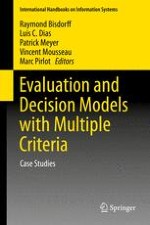2015 | OriginalPaper | Buchkapitel
5. The EURO 2004 Best Poster Award: Choosing the Best Poster in a Scientific Conference
verfasst von : Raymond Bisdorff
Erschienen in: Evaluation and Decision Models with Multiple Criteria
Verlag: Springer Berlin Heidelberg
Aktivieren Sie unsere intelligente Suche, um passende Fachinhalte oder Patente zu finden.
Wählen Sie Textabschnitte aus um mit Künstlicher Intelligenz passenden Patente zu finden. powered by
Markieren Sie Textabschnitte, um KI-gestützt weitere passende Inhalte zu finden. powered by
